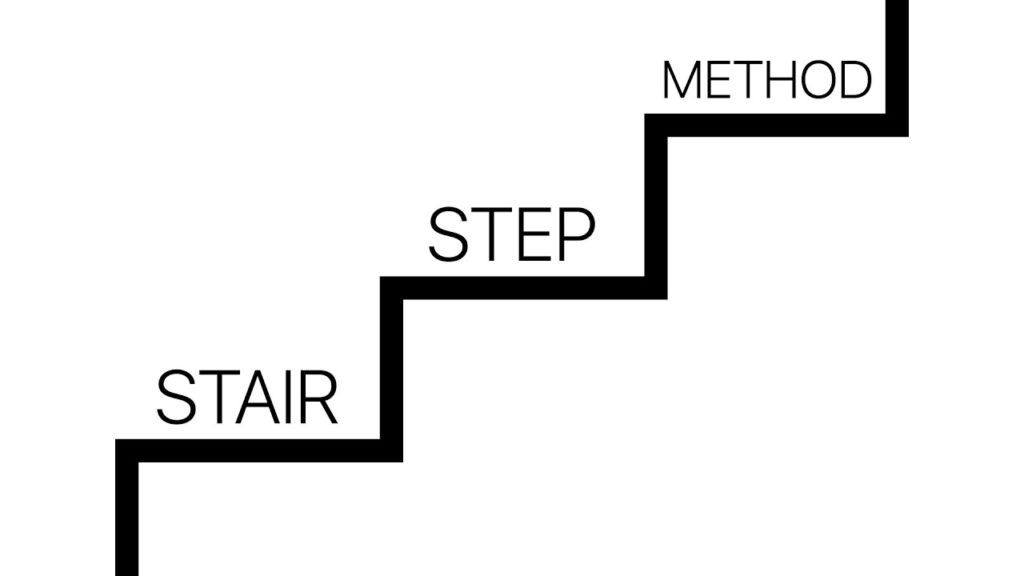ShareFrom sales and marketing to finance, operations, and hiring, there is often a big learning curve for first-time entrepreneurs. This learning curve is even steeper for more complex business models such as SaaS companies, the Stairstep approach can help with this.
If you are building a business, there are essentially three routes that you can take:
- Build a startup, raise VC money and and adopt the “Go big or go home approach,” (i.e. you have to build a business big enough for investors to get a sizeable return.)
- Keep your day job and work like crazy on nights and weekends on your “side hustle” until your company is big enough to work on it full-time.
- I’d argue that there’s a third, more conscious approach. It is called the Stairstep Approach. It allows you to level up and grow at a slow and steady pace while still maintaining full control of the business.
First coined by Rob Walling, the Stairstep Approach is what I used to start Bean Ninjas back in 2015. In this post, I’m going to share how I used this strategy.
Editor’s Note: If you are looking to scale your business, download our free Xero Toolkit for small businesses.
Article Contents
What’s the Stairstep Approach?
The stairstep approach allows bootstrapped founders to “level up” their skills and businesses without giving up control to VCs, incurring debt, or burning out. Share on XThe main premise of this approach is that you build your entrepreneurial skillset as you get more experience. Rather than starting with a complex business model (i.e., a SaaS company, a marketplace business, a membership community, etc), you start with something slightly easier to run like a service-based business, such as being a consultant or running an agency.
Then, as you build your experience, bank balance, and network, you can “level up” by either expanding your business or starting new, more complex businesses.
In Rob’s case, he went from consulting to building single-channel products to founding Drip, an email & marketing automation SaaS product.
This approach is especially helpful for bootstrapped businesses. Some advantages include:
- Ease into entrepreneurship without having to take on VC funds or incur tons of debt.
- Grow the company at a slow, steady and sustainable pace instead of having to risk it all for “hockey stick growth” that VCs want to see.
- Maintain full control of the business (i.e. you control the direction and growth)
- Build a financial freedom engine, similar to what Dan Andrews’ talks about in his book, Before The Exit.
Understanding the biggest drawback to this approach
While less risky than some other methods, the Stairstep Approach isn’t for everyone. There are some real drawbacks.
The biggest one is time.
You are going to need patience as you develop these skills, gain valuable experience, and generate enough cash flow to fund all of your ideas.
Generally, the more complex the business, the longer it typically takes to become profitable.
The more complex the business, the longer it typically takes to become profitable Share on X
For example, in this TropicalMBA blog post, Dan coins the 1,000 Day Principle, which states that it takes a founder about 1,000 days until they are able to make the same (or more) from their business than their corporate salary. For many SaaS businesses, it can take five or more years before the business is truly profitable.
As the CEO of Bean Ninjas, here is how this approach has played out for me.
Step 1: Transitioning from employee to consultant
Similar to Rob, I quit my full-time job and transitioned from an employee to a consultant. This had immediate advantages, including more freedom over time, higher profit margins, and more earning potential.
The challenge with a consulting business is it can be difficult to scale.
Step 2: Scaling a productized service
After learning about productized services I realized this business model could help solve my challenges in scaling a consulting business.
Because you have a clear pricing model and aren’t doing custom work each time, productized services are easier than consulting to build systems, hire a team and scale.
We launched Bean Ninjas following the methodology laid out in Dan Norris’s book, The 7-Day Startup, We got our first customer the week we launched.
While we had customers from day one, it would still take us 18 months to grow it to the point where I could work in the company full-time and stop taking on one-off consulting work.
Pro Tip: Productized services are just one example of how you can level up your business. Other examples are simple product and software businesses where you rely mainly on one sales channel — for example, WordPress plugins, Shopify apps, or Magento add-ons.
You keep leveling up in this stage until you gain much-needed experience and confidence. Not to mention, it is a great way to diversify your risks.
One of the challenges with a service business compared to a product business is that as your revenue grows so too does the number of people you need to deliver the service.
Step 3: Building our first product
The easiest way for us to build a ‘product’ at Bean Ninjas was to develop our own online courses. We started with a ‘How to do your bookkeeping in Xero course’ and followed up with a ‘Know your Numbers: Key financial reports for business owners’ course.
With services you get paid upfront or within a few weeks of sending your invoice. In creating our online course we needed to invest significant resources upfront in creating the course content.
While developing products, software or running businesses like marketplaces and membership communities have more scalable, have higher margins and more potential to create financial freedom. However, they take longer to ramp up and get to profitability. And, many businesses never make it to this point at all.
As for us at Bean Ninjas, it took us four years to get to this point, and start building and launching infoproducts.
Using the Stairstep Approach to level up your entrepreneurial skills
From leadership and people management to sales, marketing, and finance, there are some skills that all entrepreneurs have to learn. If you are a bootstrapped business, you can use the Stairstep approach to fast-track some of the learning (and avoid some common mistakes.
- 1 – learning about finding product market fit, sales, managing cash-flow
- 2 – learning about scaling, leading teams, setting vision and values, marketing, building a network
- 3 – apply that knowledge to a more complex business
Regardless of what stage you are at, there are some skills that all entrepreneurs will need to learn.

Vision and communication
The most important skill that all entrepreneurs need to learn is how to be lead and inspire others. Share on XEntrepreneurs often have incredible visions, however to build a business you need the ability to communicate your vision and inspire others. Your team, customers, partners and stakeholders all need to buy into your vision.
When I started Bean Ninjas back in 2015, my original vision was to build a 7-figure business and work less than 20 hours per week, so I could spend more time surfing. This is great for me, but not a very inspiring vision for others who work for me.
I needed to have a clear vision and purpose that the whole team could feel excited about it. This isn’t something that you can crank out by yourself in an afternoon. It takes time to collaborate on with your entire team.
Bean Ninjas’ mission is to educate & support 10,000 entrepreneurs to know their numbers and make data-driven decisions in order to achieve true freedom.
Once we had a compelling mission in place, I had to learn how to communicate and embody it day in and day out to the rest of the team.
Leadership and people management
Having the ability to lead a team, attract and motivate great people is critical when building a business.
Coming into your business some people will have more experience hiring and managing people than others.
While I had managed a few staff I hadn’t built a team from scratch prior to Bean Ninjas.
For example, this is the first org chart for Bean Ninjas. As you can see, in the early days, I was responsible for almost every box in the org chart.
Now, this is our most up-to-date org. chart. My name is only in the CEO box, and have removed myself from all the day-to-day operations.
You can create systems.
When we needed to hire another accountant recently, I wasn’t involved in any part of the process. Someone else in the team organized the interview, tested their Xero and accounting skills, assessed cultural fit, organized the background check, issued the contract, and handled our new team member onboarding process.
Sales and Marketing
Cash is the lifeblood of any business. You won’t be in business long if you don’t have any sales.
In our case, this meant building the Bean Ninjas brand rather than creating a business tied to my personal expertise as an accountant.
We make a point of having various team members, in addition to our founders, involved in representing the brand. Whether it be featuring them on the podcast or blog or having team members present at meetups and conferences.
Building a brand and audience not only generated leads and awareness for our core Bean Ninjas bookkeeping services, but it also provided a platform we leveraged for our course launches.
Conclusion
From learning how to be a CEO to building a brand, there are a lot of lessons that you can only learn from experience.
When you use a more gradual process like the Stairstep Approach, it can help you level up without taking on crippling amounts of debt, diluting your equity down to 50% or less in the company, or burning out.
[content_upgrade cu_id=”3030″]Get the bonus content: Useful Tools to Scale Your Business[content_upgrade_button]Click Here[/content_upgrade_button][/content_upgrade]







